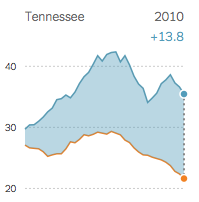Chance News 97: Difference between revisions
m (→Quotations) |
|||
| Line 8: | Line 8: | ||
Submitted by Paul Alper | Submitted by Paul Alper | ||
---- | |||
"[Choosing] what to do in the face of uncertainty is never a scientific question. The science is elucidating the possibilities and the probabilities but how to act and how to react is your own values. And we always have to make that explicit. But if you don’t have any information, it’s hard to know how to apply your values in more than a random way." | |||
<div align=right>-- Stephen Schneider, quoted in [http://dotearth.blogs.nytimes.com/2013/12/20/climate-scientists-then-and-now-espousing-responsible-advocacy/?_r=0 Climate scientists, then and now, espousing ‘responsible advocacy’], <br> | |||
Dot Earth blog, ''New York Times'', 20 December, 2013</div> | |||
Submitted by Bill Peterson | |||
==Forsooth== | ==Forsooth== | ||
Revision as of 21:19, 7 January 2014
Quotations
I beseech you, in the bowels of Christ, think it possible that you may be mistaken. --Oliver Cromwell
Cromwell's rule, named by statistician Dennis Lindley, states that the use of prior probabilities of 0 or 1 should be avoided, except when applied to statements that are logically true or false. For instance, Lindley would allow us to say that Pr(2+2 = 4) = 1, where Pr represents the probability. In other words, arithmetically, the number 2 added to the number 2 will certainly equal 4.
Submitted by Paul Alper
"[Choosing] what to do in the face of uncertainty is never a scientific question. The science is elucidating the possibilities and the probabilities but how to act and how to react is your own values. And we always have to make that explicit. But if you don’t have any information, it’s hard to know how to apply your values in more than a random way."
Dot Earth blog, New York Times, 20 December, 2013
Submitted by Bill Peterson
Forsooth
“The difference in mortality rates [in deaths per 100,000 women] between black women [top curve] and white women [bottom curve] with breast cancer has widened since 1975, in part because black women have not benefited as much from improvements in screening and treatment. Among the states with available data, Tennessee has the largest gap—with nearly 14 black women dying for every one white woman.”
The phrase in bold appeared in the printed National Edition (p. A22) but was removed without comment from the online version by Dec. 24. None of the 162 online comments on the accompanying article questioned the phrase.
Submitted by Paul Campbell
